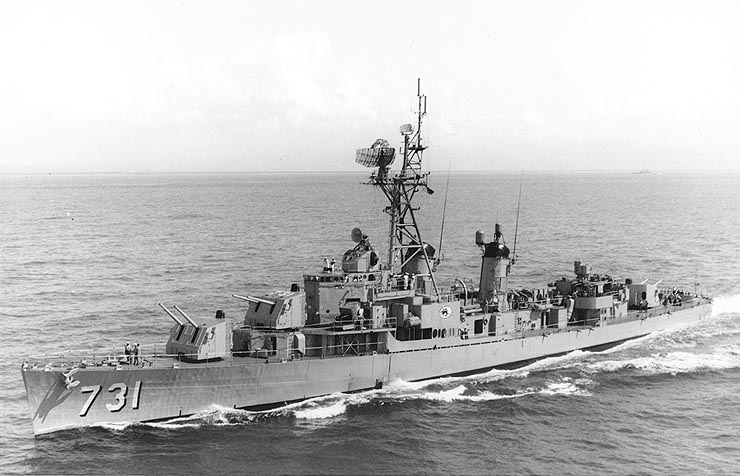On April 28, 2015, a Saudi-owned news outlet, Al-Arabiya, first published the news that an American-flagged cargo ship, the MV Maersk Tigris, had been fired upon by Iranian Islamic Revolutionary Guards Corps Naval vessels in the Strait of Hormuz. The ship, which was carrying 34 Americans, was then towed into the Iranian port of Bandar Abbas. The news of Americans captured by Iran triggered alarm from many commentators, with many suggesting the action undermined the image of Iran’s current president, Hassan Rouhani, as a moderate seeking dialogue with the West. As more news was released, however, it became clear that the vessel was not in fact American; it was a Marshall Islands-flagged ship of Danish ownership and Singaporean charter. Furthermore, none of the crew were American citizens. Worries that the ship was seized to send a message of hostility were interspersed with reports that it had been seized due to a financial dispute between the Iranian port authority and the vessel’s owners. It remains too early to understand what were the exact circumstances of the seizure or what specific constellation of objectives and goals motivated the Iranian actions. However, the uncertainty and confusion regarding the episode parallels another incident in American history, that of the Tonkin Gulf in 1964, and reinforces a crucial lesson: a lack of concrete information can lead to faulty decision-making and strategic failures in addressing international crises.
On August 2, 1964, North Vietnamese torpedo boats attacked the American warship USS Maddox. The vessel, which had been holding position off of North Vietnam in the Tonkin Gulf to support ongoing covert operations, avoided damage from the torpedo and small arms attack. Two days later, the Maddox and the USS Turner Joy both reported hostile contacts with multiple patrol boats firing machine guns and torpedoes, and fired their main armaments and small arms in response. The reports from the destroyers, combined with signals intelligence that seemed to indicate North Vietnamese support of the attacks, convinced President Johnson, Defense Secretary Robert McNamara, and other senior Washington policymakers that there had in fact been a concerted assault on the U.S. ships.
In response to the attack, American aircraft launched retaliatory bombing raids on North Vietnam, destroying an oil depot but losing two planes in the process. Additionally, President Johnson asked Congress to pass the “Tonkin Gulf Resolution,” giving the president authority to use “any means necessary to repel aggression in Southeast Asia.” In later years, this resolution would serve as the legal justification for American involvement in the Vietnam War.
Recent years have seen significant questioning of the circumstances of the Tonkin Gulf incident. Historians have suspected that the second attack, which prompted the military response and the Congressional action, was the result of equipment error and excited sailors. Many experts believe that no North Vietnamese forces actually attacked the Americans on the night of August 4. Recent scholarship and declassified documents from several government archives have confirmed this interpretation, and even Defense Secretary McNamara concurred. The legal justification for waging the war in Vietnam by presidential fiat was based on what was likely a fallacy, and, at worst, a fabrication.
As with all historical parallels, it is fallacious to draw a direct line of comparison between the complex events of 1964 and the seizure of the MV Maersk Tigris just a few days ago. Unlike the Maddox and Turner Joy, which were supporting covert operations against North Vietnam, the Tigris was simply transiting a vital international waterway. The United States, furthermore, does not have the same level of hostile relationship with Iran as it did with North Vietnam in 1964. And unlike the second attack in the Tonkin Gulf, it seems indisputable, at least thus far, that Iran did in fact fire upon, board, and divert the Tigris deeper into Iranian territory.
The value of remembering the Gulf of Tonkin incident when considering the latest events on the high seas, however, comes not in the specific similarities of the situations, but in application of the deeper underlying lessons from 1964 to today. The Tonkin Gulf incident clearly demonstrated that initial information and even eyewitness reports can be entirely mistaken and divorced from reality. The flood of information that has been added to update news about the Tigris seizure since it was first reported demonstrates once again that initial information on exact circumstances is often very spotty.
This inaccurate information drastically raises the possibility of misjudgments and miscalculations. The failure to consider alternative explanations in the Tonkin Gulf case helped propel American escalation in Vietnam, a strategic decision that embroiled the United States in a war that cost tens of thousands of American lives and millions of dollars. This is not to say that the Iranian actions in the Strait of Hormuz are justified. It is entirely possible, even likely, that the Revolutionary Guard’s seizure of the Tigris was not due to a legitimate financial dispute, but rather a response to the deployment of American warships to the waterways off Yemen to confront an Iranian convoy sailing to support the Houthi rebels there. Nevertheless, failing to learn the crucial lesson of Tonkin Gulf and assessing events and motives before all the information is known creates a great potential for strategic misperception, political miscalculation, and policy failure.
Image source: Wikimedia // U.S. Navy
